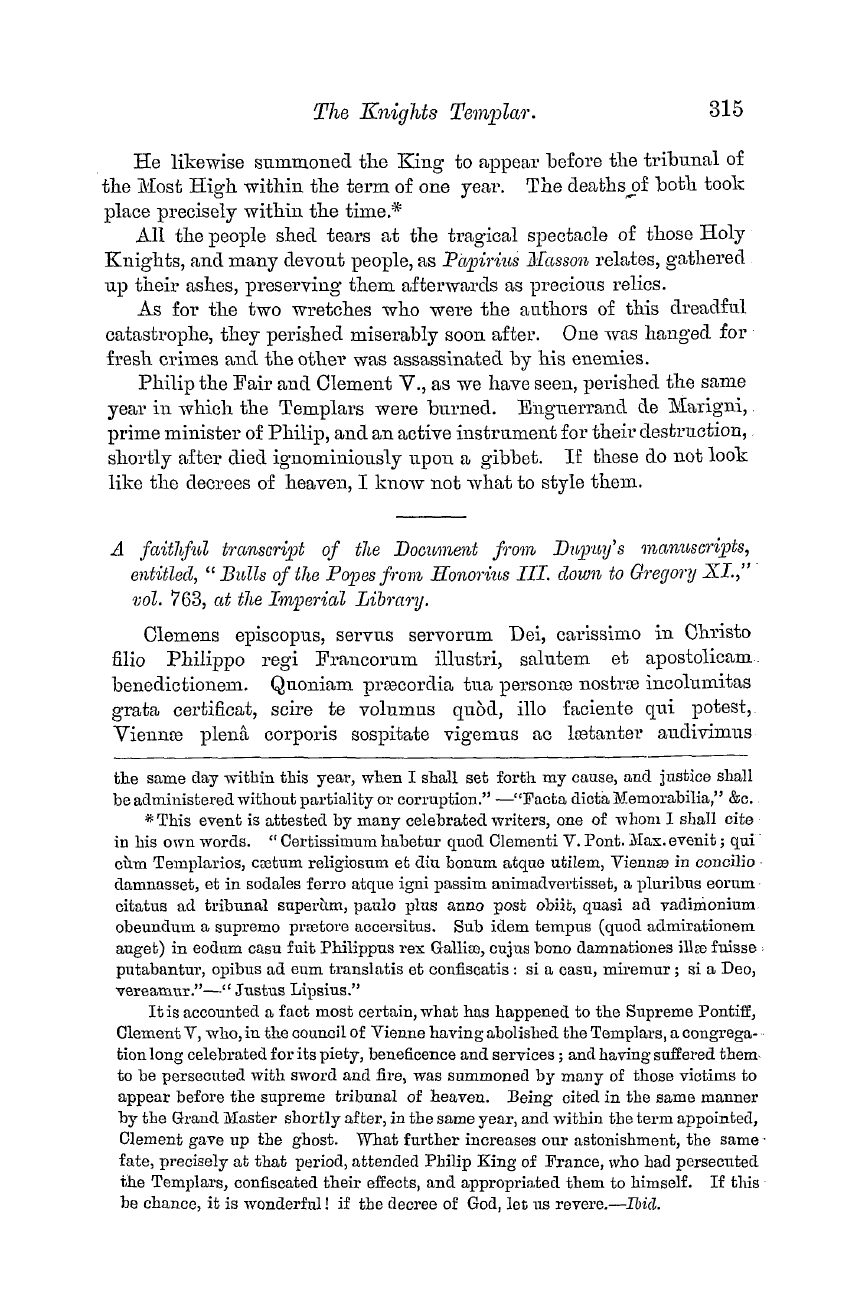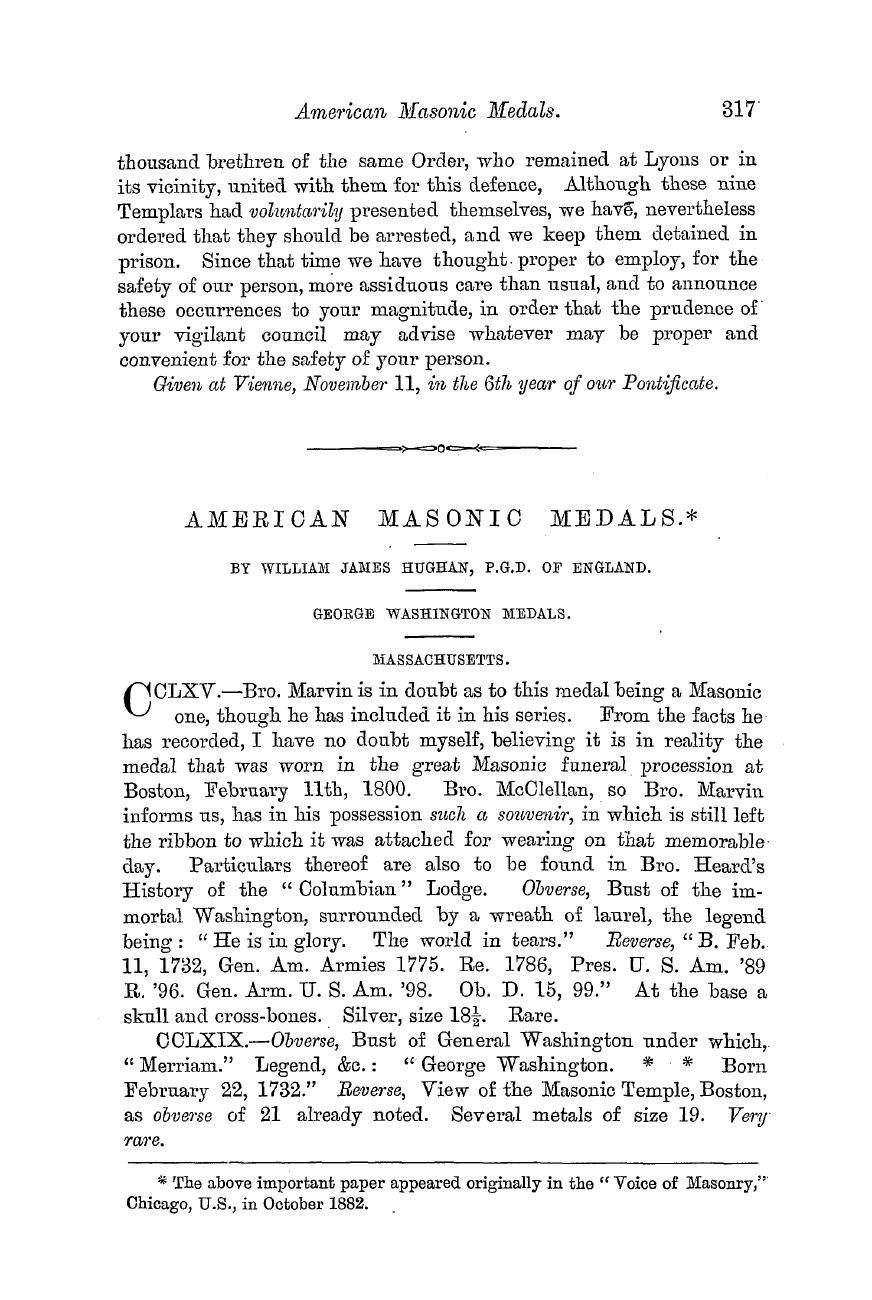Note: This text has been automatically extracted via Optical Character Recognition (OCR) software.
The Legend Of The Introduction Of Masons Into England.
I give the above in full , although already mentioned m the extracts from the ecclesiastical history , from its interest , and as showing how rude many of the " monasteries " as they are called , were in their construction . They were certainly houses for holy men , but not monasteries as we should understand the term . The house at the
landing place , brings to mind the hospice erected by thefreres-hospitaliers pontifes . In the use of the term living rock , " vivatn rupem " will be found perhaps a reply to a recent query as to the meaning of " lapidibus vivis . " *
" The walls of the city [ Carlisle ] and a fountain of marvellous workmanship , constructed by the Romans , " are mentioned , and on Cuthbertf arriving at a place where there was neither a church nor any habitation . ' ] : " Tents were therefore erected by the way side ; and by cutting down branches from the neighbouring forest , each man
built a booth , such as best he could for himself wherein to abide . " Bede records that near the church to the south , " there is shown , to this day the very pit into which this memorable water was poured ; it is in the form of a square , in every part surrounded by wood and filled with pebbles . " The water referred to is that in which the dead
body of St . Cuthbert was washed , and it is worthy of notice that so sacred a place—a piece of mould from which when mixed with water , is reported to have cured a boy " vexed with a most cruel sjvirit , " is surrounded by wood and not by stone .
In Bede s " Six Ages of the World , " a few items of information already given are repeated , including the trench of Severus and the walls of turves and stone . The important statements made in the " Lifes of the Abbots of Wearmouth and Jarrow " , has already been iven
g . The annals of the reign of Alfred the Great , from A . D . 849 , to A . D . 887 , by Asser , a monk of the Benedictine monastery of St . David's , and afterwards Bishop of Sherburne , coincides largely in its facts with the Saxon chronicle . Asser died in 910 .
Some discussion , with references on the theories of the age of these annals will be found in the introduction by Mr . Stevenson , to vol . II . part 2 of the " Church Historians of England . " Under the year 851 , § referring to the Island of Sheppey , it is stated that " a very beautiful monastery has been built on it . " In 867 , on the Pagans having retired into York , the Christians determined to break down the walls . \\ " In this they succeeded , for at that time the city
Note: This text has been automatically extracted via Optical Character Recognition (OCR) software.
The Legend Of The Introduction Of Masons Into England.
I give the above in full , although already mentioned m the extracts from the ecclesiastical history , from its interest , and as showing how rude many of the " monasteries " as they are called , were in their construction . They were certainly houses for holy men , but not monasteries as we should understand the term . The house at the
landing place , brings to mind the hospice erected by thefreres-hospitaliers pontifes . In the use of the term living rock , " vivatn rupem " will be found perhaps a reply to a recent query as to the meaning of " lapidibus vivis . " *
" The walls of the city [ Carlisle ] and a fountain of marvellous workmanship , constructed by the Romans , " are mentioned , and on Cuthbertf arriving at a place where there was neither a church nor any habitation . ' ] : " Tents were therefore erected by the way side ; and by cutting down branches from the neighbouring forest , each man
built a booth , such as best he could for himself wherein to abide . " Bede records that near the church to the south , " there is shown , to this day the very pit into which this memorable water was poured ; it is in the form of a square , in every part surrounded by wood and filled with pebbles . " The water referred to is that in which the dead
body of St . Cuthbert was washed , and it is worthy of notice that so sacred a place—a piece of mould from which when mixed with water , is reported to have cured a boy " vexed with a most cruel sjvirit , " is surrounded by wood and not by stone .
In Bede s " Six Ages of the World , " a few items of information already given are repeated , including the trench of Severus and the walls of turves and stone . The important statements made in the " Lifes of the Abbots of Wearmouth and Jarrow " , has already been iven
g . The annals of the reign of Alfred the Great , from A . D . 849 , to A . D . 887 , by Asser , a monk of the Benedictine monastery of St . David's , and afterwards Bishop of Sherburne , coincides largely in its facts with the Saxon chronicle . Asser died in 910 .
Some discussion , with references on the theories of the age of these annals will be found in the introduction by Mr . Stevenson , to vol . II . part 2 of the " Church Historians of England . " Under the year 851 , § referring to the Island of Sheppey , it is stated that " a very beautiful monastery has been built on it . " In 867 , on the Pagans having retired into York , the Christians determined to break down the walls . \\ " In this they succeeded , for at that time the city































































